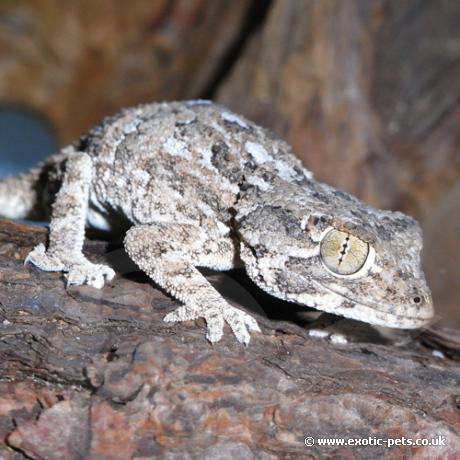

The Helmeted Geckos is a small nocturnal species found in rocky deserts of Morocco. This species is quite hard to find within the pet trade.
| Origin | Morocco |
|---|---|
| Environment | Rocky Deserts and Shrublands |
| Adult Size | 4inches |
| Suitability | Novice |
| Lifespan | 8 Years + |
| Temperament | Skittish |
Helmeted Geckos are a small and unique looking gecko that get their name due to the row of enlarged scales along the back of their neck that overhang, giving them the appearance of a helmet. This often makes them look like they’re always grumpy. Both males and females do have variable patterning and sandy colouration which helps them blend into their environment. On average they only grow to be around 3-4inches in size with males being relatively smaller than females.
Arid and rocky deserts along the coast of Northwest Africa is home to much of the population of Helmeted Geckos. This environment suits them as they can camouflage amongst the rocks and debris which holds more moisture throughout the day as rainfall isn’t heavy. Most of their water intake is down to heavy fog, which is common for all species living amongst the costal regions.
Due to their size Helmeted Geckos don’t require too large of an enclosure. A glass terrarium or wooden vivarium 2-3ft in size would be ideal. Being ground dwellers its best to have an enclosure with more floor space but still provide branches and décor for the geckos to climb over. They are a super hardy species and do thrive If given the correct care. Females can be housed together with no issue if there are plenty of hides for them to escape each other if needs be. Males can be territorial so it’s best to only have one male on his own or to a female heavy group.
Temperatures for this species should remain around 85-90F during the day with a night time drop around 70-80F. For a glass enclosure you could always use a heat mat or heat cable connected to a thermostat to control the temperature. For a wooden vivarium a heat light connected to a dimming or pulse thermostat would be best. A heat guard around the bulb will also prove beneficial to prevent the gecko from burning itself if it gets too close to the light. UVB is not essential for Helmeted Geckos however it would prove highly beneficial. Personally, we provide all our geckos with UVB and they do thrive better and will often expose their tail or full bodies to the UVB during the day.
Prorep Leo life is a perfect substrate to use as this replicates their natural environment and lasts well too. A humid hide will also prove beneficial in the enclosure and should be misted on a weekly basis to help maintain humidity levels.
Caves and rock dens are also a great way to create natural hides, though other décor can be used alongside. Fake or real plants can be added to the enclosure however we do recommend using an LED spotlight or strip for real plants to achieve maximum growth and nourishment.
Helmeted geckos will eat a variety of live food including crickets, locusts, mealworms, roaches and more. Regular calcium and vitamin powder supplements should be added to the food on a regular basis to help with bone and muscle development.
Though Helmeted geckos don’t always have access to open water in the wild we do find its best to have a small water bowl in the enclosure for when they need it.
When it comes to handling Helmeted Gecko can and will move fast so it is best to handle low to the ground for if they get spooked. Generally, the geckos do get used to where their food source is coming from and they can become relatively tame.